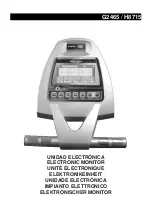
Combination Algorithms [Ò+Ó]
Algorithm Reference-69
Mix
Effect
Adjusts the amount of each effect that is mixed together as the algorithm wet signal.
Negative values polarity-invert that particular signal.
A
/Dry->
B
This parameter controls how much of the A effect is mixed with dry and fed into the B
effect. A and B are designated in the algorithm name. This control functions like a
wet/dry mix, where 0% is completely dry and 100% is effect A only.
Signal Routing (3 effects)
The algorithms listed above with three effects allow serial or parallel routing between any three effects. Effect A is
wired to the input of effect B and C, and effect B is wired into effect C. The input of effect B is a mix between effect
A and the algorithm dry input. The input into effect C is a three-way mix between effect A, effect B, and the dry
signal.
As in the two-effect routing, the input of effect B is controlled by a parameter
A
/Dry>
B
. For example, in
Chor+Dly+Rvb, the parameter name is ÒCh/Dry>DlyÓ.
The input into effect C is controlled by two parameters named A/B ->* and */Dry->C where A, B, and C
correspond to the names of effects A, B, and C. The first parameter mixes effect A and B into a temporary buffer
represented by the symbol Ò*Ó. The second parameter mixes this temporary buffer Ò*Ó with the dry signal to be fed
into effect C. These mixing controls function similarly to Wet/Dry parameters. A setting of 0% only mixes the effect
to the right of the Ò/Ó in the parameter name, while 100% only mixes the effect to the left of the Ò/Ó. Negative values
polarity-invert the numeratorÕs signal.
Effects A, B, and C outputs are mixed at the algorithm output to become the wet signal. Separate mixing levels are
provided for left and right channels, and are named ÒL MixÓ or ÒR MixÓ. Negative mix amounts polarity-invert the
signal which can change the character of each effect when mixed together or with the dry signal. The Wet/Dry
parameter adjusts the balance between the sum of all effects determined by the Mix parameters, and the input dry
signal. Negative Wet/Dry values polarity-invert the summed wet signal relative to dry.
An example of routing using Delay+Reverb
Chorus
Delay
Reverb
Blend
Blend
Input
Blend
Blend
Output
Mix Delay
Mix Chorus
Mix Reverb
Out Gain
Wet/Dry
Ch/Dry->Dly
Ch/Dly->*
*/Dry->Rvb
















































